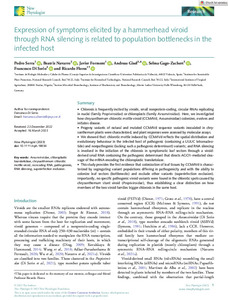| dc.contributor.author | Serra, P. |
| dc.contributor.author | Navarro, B. |
| dc.contributor.author | Forment, J. |
| dc.contributor.author | Gisel, A. |
| dc.contributor.author | Gago‐Zachert, S. |
| dc.contributor.author | Di Serio, F. |
| dc.contributor.author | Flores, R. |
| dc.date.accessioned | 2023-05-18T07:32:43Z |
| dc.date.available | 2023-05-18T07:32:43Z |
| dc.date.issued | 2023-05-06 |
| dc.identifier.citation | Serra, P., Navarro, B., Forment, J., Gisel, A., Gago‐Zachert, S., Di Serio, F. & Flores, R. (2023). Expression of symptoms elicited by a hammerhead viroid through RNA silencing is related to population bottlenecks in the infected host. New Phytologist, 1-15. |
| dc.identifier.issn | 0028-646X |
| dc.identifier.uri | https://hdl.handle.net/20.500.12478/8174 |
| dc.description.abstract | Chlorosis is frequently incited by viroids, small nonprotein-coding, circular RNAs replicating in nuclei (family Pospiviroidae) or chloroplasts (family Avsunviroidae). Here, we investigated how chrysanthemum chlorotic mottle viroid (CChMVd, Avsunviroidae) colonizes, evolves and initiates disease. Progeny variants of natural and mutated CChMVd sequence variants inoculated in chrysanthemum plants were characterized, and plant responses were assessed by molecular assays. We showed that: chlorotic mottle induced by CChMVd reflects the spatial distribution and evolutionary behaviour in the infected host of pathogenic (containing a UUUC tetranucleotide) and nonpathogenic (lacking such a pathogenic determinant) variants; and RNA silencing is involved in the initiation of the chlorosis in symptomatic leaf sectors through a viroid derived small RNA containing the pathogenic determinant that directs AGO1-mediated cleavage of the mRNA encoding the chloroplastic transketolase. This study provides the first evidence that colonization of leaf tissues by CChMVd is characterized by segregating variant populations differing in pathogenicity and with the ability to colonize leaf sectors (bottlenecks) and exclude other variants (superinfection exclusion). Importantly, no specific pathogenic viroid variants were found in the chlorotic spots caused by chrysanthemum stunt viroid (Pospiviroidae), thus establishing a clear distinction on how members of the two viroid families trigger chlorosis in the same host. |
| dc.description.sponsorship | Ministerio de Economıa y Competitividad of Spain |
| dc.description.sponsorship | Consiglio Nazionale delle Ricerche |
| dc.format.extent | 1-15 |
| dc.language.iso | en |
| dc.subject | Rna |
| dc.subject | Pathogenesis |
| dc.subject | Viroids |
| dc.title | Expression of symptoms elicited by a hammerhead viroid through RNA silencing is related to population bottlenecks in the infected host |
| dc.type | Journal Article |
| cg.contributor.crp | Roots, Tubers and Bananas |
| cg.contributor.affiliation | Universitat Politecnica de Valencia |
| cg.contributor.affiliation | Institute for Sustainable Plant Protection, Italy |
| cg.contributor.affiliation | Institute for Biomedical Technologies, Italy |
| cg.contributor.affiliation | International Institute of Tropical Agriculture |
| cg.contributor.affiliation | Martin Luther University Halle-Wittenberg |
| cg.coverage.hub | Headquarters and Western Africa Hub |
| cg.researchtheme | Biotech and Plant Breeding |
| cg.identifier.bibtexciteid | SERRA:2023 |
| cg.isijournal | ISI Journal |
| cg.authorship.types | CGIAR and advanced research institute |
| cg.iitasubject | Disease Control |
| cg.iitasubject | Food Security |
| cg.iitasubject | Plant Diseases |
| cg.journal | New Phytologist |
| cg.notes | Open Access Article; Published online: 06 May 2023 |
| cg.accessibilitystatus | Open Access |
| cg.reviewstatus | Peer Review |
| cg.usagerightslicense | Creative Commons Attribution 4.0 (CC BY 0.0) |
| cg.targetaudience | Scientists |
| cg.identifier.doi | https://doi.org/10.1111/nph.18934 |
| cg.iitaauthor.identifier | ANDREAS GISEL: 0000-0001-7218-9488 |
| cg.futureupdate.required | No |

